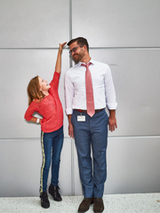

“Your child has kidney stones.”
It’s shocking news — and Gregory Tasian, MD, MSc, MSCE, a urologist and researcher at Children’s Hospital of Philadelphia (CHOP), has delivered it to hundreds of parents.
Even more shocking, Tasian says, is the fact that over the last 20 years, the likelihood that a child will develop a kidney stone has doubled.

That dramatic rise prompted the Hospital to create the Pediatric Kidney Stone Center, where a multidisciplinary team of clinicians cares for children with this painful, often lifelong condition — and conducts research that strives to answer the questions families ask every day: Why is this happening? What can I do?
Searching for answers
It’s a field that’s ripe for breakthroughs. “When you have such a dramatic change over such a short period of time, there’s a gap in the knowledge base of how to treat these patients effectively,” Tasian says.
“I’m not saying diet is not part of it, but I think we need to look beyond that,” he says. “For example, the rise in the incidence of stones far outpaces the rise of obesity in the population. Presumably a lot of the dietary choices that would affect stone risk also affect obesity risk, but we’re seeing different rates of rise, so to me that suggests there’s something else going on.”
As temperatures rise, so does stone risk
Kidney stone treatment
With funding from the National Institutes of Health and other sources, Tasian and his colleagues are leading a number of studies to better understand kidney stones and find new treatments and prevention strategies. A well-received study the team published in 2014 found that the risk of presenting with kidney stones peaked within just a few days of exposure to hot temperatures.
Building on this work, the team is exploring different strategies for getting kids to increase their water intake, some of which they are currently piloting in Philadelphia public schools. The team is also looking at whether the amount of zinc in children’s diets affects their risk of developing stones and exploring a possible link between stones and antibiotic use.
In recognition of his work, Tasian received the 2016 Young Physician-Scientist Award from the American Society for Clinical Investigation.
He has also received something even more meaningful: the unwavering support of his patients, almost all of whom are enrolled in one of his team’s research studies.
“These studies are going to help us define the treatments of the future,” says Tasian. “Our families feel like they’re part of something that will hopefully help their child — and will almost certainly help other children.”
Featured in this article
Specialties & Programs

“Your child has kidney stones.”
It’s shocking news — and Gregory Tasian, MD, MSc, MSCE, a urologist and researcher at Children’s Hospital of Philadelphia (CHOP), has delivered it to hundreds of parents.
Even more shocking, Tasian says, is the fact that over the last 20 years, the likelihood that a child will develop a kidney stone has doubled.

That dramatic rise prompted the Hospital to create the Pediatric Kidney Stone Center, where a multidisciplinary team of clinicians cares for children with this painful, often lifelong condition — and conducts research that strives to answer the questions families ask every day: Why is this happening? What can I do?
Searching for answers
It’s a field that’s ripe for breakthroughs. “When you have such a dramatic change over such a short period of time, there’s a gap in the knowledge base of how to treat these patients effectively,” Tasian says.
“I’m not saying diet is not part of it, but I think we need to look beyond that,” he says. “For example, the rise in the incidence of stones far outpaces the rise of obesity in the population. Presumably a lot of the dietary choices that would affect stone risk also affect obesity risk, but we’re seeing different rates of rise, so to me that suggests there’s something else going on.”
As temperatures rise, so does stone risk
Kidney stone treatment
With funding from the National Institutes of Health and other sources, Tasian and his colleagues are leading a number of studies to better understand kidney stones and find new treatments and prevention strategies. A well-received study the team published in 2014 found that the risk of presenting with kidney stones peaked within just a few days of exposure to hot temperatures.
Building on this work, the team is exploring different strategies for getting kids to increase their water intake, some of which they are currently piloting in Philadelphia public schools. The team is also looking at whether the amount of zinc in children’s diets affects their risk of developing stones and exploring a possible link between stones and antibiotic use.
In recognition of his work, Tasian received the 2016 Young Physician-Scientist Award from the American Society for Clinical Investigation.
He has also received something even more meaningful: the unwavering support of his patients, almost all of whom are enrolled in one of his team’s research studies.
“These studies are going to help us define the treatments of the future,” says Tasian. “Our families feel like they’re part of something that will hopefully help their child — and will almost certainly help other children.”
Contact us
Pediatric Kidney Stone Center